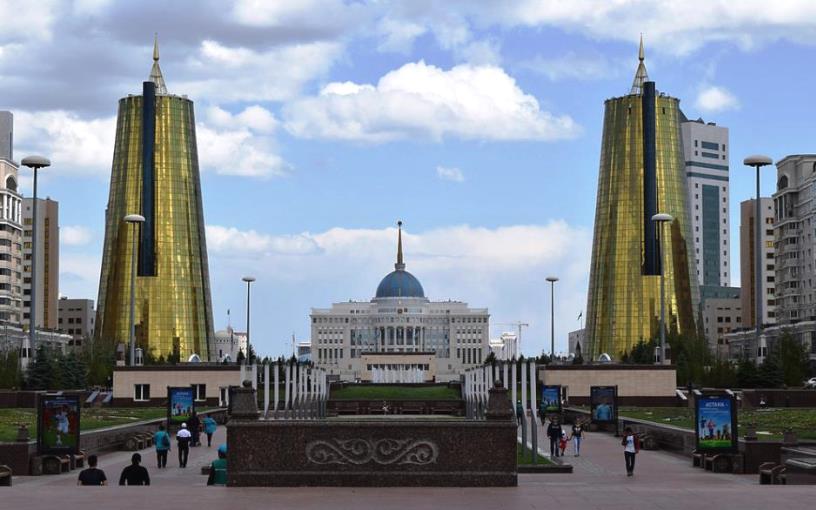(PONARS Eurasia Policy Memo) Despite a history of using discourses of danger to define other transnational challenges (e.g., Islamic radicalism), Central Asia’s governments have not framed the coronavirus pandemic in security terms. Using examples of Kazakhstan, Kyrgyzstan, and Uzbekistan, we explain this ambivalence by examining legitimization practices that have constrained and shaped the Central Asian regimes’ narratives and responses to COVID-19. Dual claims to presidential authority in Kazakhstan, a leadership vacuum and elite division in Kyrgyzstan, and a turn toward technocratic governance in Uzbekistan have led to an inconsistent and limited securitization of the pandemic.
In assessing Central Asian responses, we emphasize the importance of following official discourses about COVID-19. Discourse is essential to producing shared perceptions of the disease, establishing boundaries of policy responses that are (or are not) permitted, and eliciting desired public behavior. Securitizing discourses in relation to COVID-19 offer an additional lens for probing the success and failure of state policies aimed at confronting the pandemic as well as people’s decisions to follow or defy them.
Securitization Syndromes One Year Later
Just over a year since the first human cases of COVID-19 were identified in Wuhan, China, in December 2019, 219 countries and territories around the world have reported a total of over 100 million confirmed cases of the coronavirus, with a death toll surpassing 2 million deaths globally. The rapid spread of COVID-19 has shifted governments’ thinking about health and security. Many countries have witnessed a move toward securitization of the health crisis by framing the novel coronavirus as an existential threat to their societies, defining it as a national security issue rather than a public policy problem, and demanding acceptance of extraordinary measures.
Approaching the pandemic as a security crisis is something one might expect among non-democratic regimes. Cloaking COVID-19 in the language of security enables autocrats to externalize its causes, divert attention away from low-performing health policies, exercise greater discretion in marshaling security resources and justify their use of coercive methods of social control. Indeed, many have noted the swelling authoritarian tendencies—increased state surveillance and the curtailment of freedoms of movement, press, and association, among others—deployed by non-democratic governments under the guise of pandemic control.
Dual Claims to Legitimacy in Kazakhstan
Kazakhstan became the first Central Asian republic to officially confirm COVID-19 cases on its territory and declare a state of emergency, which it did on March 15, 2020. Kazakhstan’s rapid response to the coronavirus was led by President Kassym-Jomart Tokayev, who has repeatedly acknowledged significant risks of the spread of coronavirus but deployed measured discourse mirroring that of the World Health Organization (WHO). Travel restrictions, suspension of operations of public transport and establishments, bans on mass gatherings, and tougher lockdown measures in major cities afforded exceptional powers to the newly created State Commission on Ensuring the State of Emergency. Military and police were called to take part in the implementation and enforcement of quarantines with more than 50,000 employees of the Minister of Interior, Ministry of Defense, and Ministry of Health working checkpoints and roadblocks around quarantine zones and medical facilities. Drones were used to keep track of unauthorized crossings, cell-phone apps monitored people’s movement, and special task forces kept tabs on online communications about COVID-19.
While Kazakhstan’s militarized response to the public health crisis and the heavy presence of law enforcement personnel conveyed a sense of urgency and a perception of threat, official discourse throughout this emergency period lacked a strong securitization message. The term “security” was not frequently used. If uttered, it sought to protect “people’s lives” and “health,” rather than the state or the nation, as referent objects.
The “anointed” successor to Nursultan Nazarbayev, Tokayev has operated in the shadow of the first president, initially deriving his own and his regime’s legitimacy from Nazarbayev’s domestic legacy and international reputation. In the last years of Nazarbayev’s presidency, Kazakhstan faced growing political and economic challenges inherited by Tokayev. The orchestrated election of the second president in June 2019 was disrupted by public protests signaling growing popular discontent with the country’s system of governance. The economic crises of 2008 and 2014 revealed serious structural deficiencies of the Kazakh economy—namely its dependence on petroleum exports. Tokayev’s efforts to carve out an independent base of presidential power, therefore, entailed considerable risk to himself as well as the ruling Nur Sultan party if he were to fail to deliver on his promises. The threat of elite insubordination or intra-elite conflict loomed large, and the parliamentary election scheduled for January 2021 was a major consideration in the president’s approach to the pandemic.
Tokayev’s discourse surrounding the pandemic, therefore, has emphasized the familiar themes of Kazakhstan’s economic accomplishments attributed to his predecessor. He stressed that the country’s extensive financial reserves built by Nazarbayev served as a guarantee of economic stability and continuity in fulfilling the state’s “social obligations” to its people. The president has tried to position Kazakhstan as a regional leader in the fight with COVID-19 and lauded the work of his government in stabilizing the coronavirus situation in the republic. His speeches have been heavily tilted toward pledges of assistance to people, especially those who have lost their sources of income and had no economic safety net.
Nazarbayev, who was diagnosed with COVID-19 in mid-June, retreated from public view. His absence empowered Tokayev, who sought to enhance his independent stature and build up his own performance legitimacy distinct from Nazarbayev’s. By mid-summer, however, the situation with the coronavirus significantly deteriorated, and the country was forced into a second lockdown on July 5, 2020. Although the president stressed the seriousness of the epidemiological situation and adverse consequences of the pandemic for public health as well as the country’s economy and investment climate, the securitizing message remained weak and interspersed with the de-securitizing agenda.
Analysts attest that people’s attitudes toward COVID-19 in Kazakhstan have mirrored the government’s indecisiveness and inconsistencies in the public authorities’ securitizing message. Many citizens did not heed the government’s demand to wear masks, socially distance, or self-isolate, thus undermining the government’s effort at containing the spread of infection.
Uzbekistan’s Technocratic Response
With six initial cases detected by mid-March in Uzbekistan, the government put in place a range of emergency measures to prevent the rapid spread of infection. It suspended foreign travel and schools, closed borders, and canceled public gatherings and sporting events. The government certainly relied heavily on its police and internal security apparatus to enforce tight restrictions that effectively banned anyone (other than essential personnel) from leaving their homes. By late March, 3,000 members of various security agencies were mobilized as a “national guard” to monitor more than 5,000 homes and apartments where persons had been quarantined. The government also mobilized neighborhood and village (mahalla) committees to enforce a lockdown and imposed fines for those in public not wearing masks or for “hiding” someone who is infected with COVID-19. However, Uzbekistan’s official rhetoric only occasionally portrayed the pandemic as an “external enemy,” falling short of naming it a national security threat. The government effectively marshaled various lines of communication—television, news media, bloggers, and spiritual leaders provided people with updates about the coronavirus situation at home and around the world.
Already by April 2020, the Uzbek government sought to frame its response as rapid and effective in controlling the pandemic. As it asserted greater control over information in an effort to monopolize discussion of the virus, the government began to disseminate messages of optimism as it openly framed its response as successful in reining in the virus’ spread. As in many other countries, the reopening was followed by a surge in new cases, by some reports an exponential increase of new infections, which led to a second shutdown by the government in July.
For President Shavkat Mirziyoyev and his administration, full-scale securitization was a risky choice inconsistent with the principles of technocratic governance in running the state and its economy. These principles have been central to the legitimizing strategy of Mirziyoyev. In contrast, the Karimov regime buttressed its claims to legitimacy in the lofty promises of security, political stability, unique national identity, and economic development. In reality, the regime leaned on a corrupt system in which elites lived off extensive rents in exchange for allegiance to the Karimov administration. The latter relied on the fear of prosecution by an extensive ring of security institutions to sustain political stability.
Upon coming to office in 2016, Mirziyoyev has pursued several policy changes to distinguish his administration from the preceding Karimov era. Alongside other legitimation strategies (such as a more open foreign policy and a limited civil society) was a new, very public turn toward effective, technocratic governance and policy reform. Mirziyoyev’s aim was not necessarily to build democracy in his country but to create a more prosperous, reputable, and globally integrated Uzbekistan and to build his legacy through economic modernization, a fight against corruption, and technocratic governance.
When the health crisis descended on Uzbekistan, it had a rather balanced economy and trade relations, low levels of dependency on commodity exports, and diversified exports. Still poorly integrated into global supply chains, Uzbekistan was not much affected by the fragmentation of the global economy due to COVID-19. Having built financial reserves, the government was able to implement a set of measures to minimize the impact on the shutdown, including a loosening of taxation on selected industries (tourism, transportation, light industry) readjustment of loans, the waiver of fines on overdue debts, and establishment of an anti-crisis fund of $1 billion.
A series of health policies were initiated as well. In response to shortages of food and medicine, state controls on food prices and medical supplies were implemented. The official rhetoric has underscored its effective actions, although it was implemented at an enormous economic cost.
The government understands that these economic crisis measures are unsustainable, and it has faced another economic problem—the decrease of remittances from Uzbek migrant workers, which are expected to drop by 35 percent (equivalent to 5 percent of Uzbekistan’s GDP). While dealing with the economic consequences of the health crisis, the Mirziyoyev government was tested by another disaster: a newly built dam collapsed near the town of Sardoba in June 2020, forcing nearly 70,000 residents of Uzbekistan and 5,400 residents of Kazakhstan out of their homes. The government’s response to the disaster demonstrated the desire of the new administration to project competence in crisis management, but it also revealed its fear of popular unrest in the face of crisis, thus underscoring the cracks in the government’s legitimacy and the president’s concerns with his reputation.
To date, Mirziyoyev’s reforms have not only failed to stamp out pervasive corruption in the country but also inflamed people’s resistance to the corrupt elite, triggering demonstrations in response to property expropriations. Fearing that the COVID-19 crisis may further exacerbate these tensions, the Mirziyoyev administration chose to frontline an image of effective policy response over securitization, consistent with its much emphasized technocratic capacity.
A Leadership Vacuum in Kyrgyzstan
On the surface, Kyrgyzstan’s response to the pandemic reflected that of its neighbors. Having announced the first COVID-19 cases in March 2020, the government declared a state of emergency and issued decrees that imposed strict quarantine measures in several areas most affected by the virus spread. To enforce the lockdown, the government instituted commandants’ offices under the Ministry of Interior and set up police checkpoints across the cities. However, from the beginning, Kyrgyzstan’s response was impaired by disorderly government communications.
Short of further guidance, the swiftly imposed lockdowns resulted in inconsistent application of new rules and a surge of abusive behavior by police and security personnel. Kyrgyzstani citizens received infrequent official information concerning the main government’s decisions that were dubbed “bureaucratic alibies” because their vague formulations raised doubt regarding their purpose and intent. The government’s clampdown on freedom of information—criminalizing the spread of allegedly false information regarding COVID-19 and denying accreditation to non-state media outlets during the state of emergency—created a vacuum of open, reliable, and accessible information.
Lack of clear leadership in spearheading the anti-COVID-19 campaign set Kyrgyzstan’s response apart from Kazakhstan and Uzbekistan. The statements of different government representatives about restrictions often contradicted each other, and public officials, including then-President Sooronbay Jeenbekov, fell flat in their responsibility to model proper behavior by refusing to wear masks themselves or appearing for photo opportunities in mass gatherings.
This vacuum of leadership was a product of Kyrgyzstan’s unique (for Central Asia) parliamentary system, where power (and legitimacy) was divided among the office of the president, the unicameral parliament (Zhogorku Kenesh), and the government (Cabinet of Ministers) with the different branches of power and individuals and agencies loath to take on responsibility for waging a concerted response to COVID-19. This was compounded by the lack of confidence of citizens in their government that has roots in poor political and economic performance by subsequent administrations. The fear of economic collapse and widespread public discontent engendered by it weighed heavily on the authorities’ decisions concerning COVID-19.
Jeenbekov was elected in October 2017, marking the first peaceful transition of power in Kyrgyzstan. At first, he relied on the support of the ruling Social Democratic Party (SDPK) and the endorsement of his predecessor Almazbek Atambayev. In the following two years, SDPK fell apart as a result of a feud between Atambayev and his successor, and in June 2019, Atambayev was stripped of his immunity from prosecution and charged with corruption. By the time of the COVID-19 outbreak, the risks of political instability in the country were running high. Splinter groups that had broken off from the SDPK formed new opposition parties threatening the dominant position of the SDPK in the parliament. Public discontent and protests over government corruption and border skirmishes with neighbors were on the rise.
Kyrgyzstan’s political elites were aware of their poor standing. With the trial drama involving the former president and his supporters unfolding in front of their eyes, a fractured political landscape, and reports of embezzlement of public and international funds during the pandemic, the authorities chose to seek stricter control over information to stave off public unrest and resorted to electoral fraud in advance of the parliamentary elections scheduled for October 2020. Widespread electoral irregularities during the parliamentary election triggered mass demonstrations that escalated in violence. To avert further turmoil, Jeenbekov announced his resignation, paving the way for the meteoric rise of the controversial leader Sadyr Japarov. As a result of this leadership vacuum and the diffusion of legitimacy across its legislative and executive branches, the government never advanced a coherent discourse, securitizing or otherwise.
Conclusion
Despite its apparent benefits, the securitization of COVID-19 in Central Asia was inconsistent, constrained, and shaped by the underlying claims of regime legitimacy in each country. While the legitimation challenges differ in each case—facing dual assertions of presidential power in Kazakhstan, preserving an image of technocratic reform in Uzbekistan, and succumbing to a leadership vacuum in Kyrgyzstan—they have made it difficult for Central Asia’s regimes to employ securitizing discourses that have worked in the past. As a result, leaders in Central Asia have one less instrument in what Edward Schatz calls a soft authoritarian toolkit, making it difficult to disguise denial, obfuscation, and misdirection within the rhetoric of securitization.
Mariya Omelicheva is Professor of National Security Strategy at the National War College, National Defense University. The views expressed in this memo are those of the author and do not represent an official position of the U.S. Government, Department of Defense, or NDU.
Lawrence Markowitz is Professor of Political Science and Chair at Rowan University.











